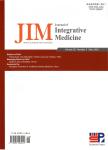Investigating short- and long-term transfer effects of a Taiji beginner course in participants' daily life
Investigating short- and long-term transfer effects of a Taiji beginner course in participants' daily life作者机构:University of Bern Institute of Complementary Medicine KIKOM
出 版 物:《Journal of Integrative Medicine》 (结合医学学报(英文版))
年 卷 期:2013年第11卷第5期
页 面:295-304页
学科分类:040304[教育学-民族传统体育学] 0403[教育学-体育学] 04[教育学] 1002[医学-临床医学]
基 金:Funding for this study was provided by Stiftung für Komplementrmedizin Gottfried und Julia Bangerter-Rhyner Stiftung and Parrotia Stiftung
主 题:Tai Ji daily life transfer effects self-efficacy longitudinal study healthy subjects Tai Ji daily life transfer effects self-efficacy longitudinal study healthy subjects
摘 要:in recent years research investigating various health benefits of Taiji practice has markedly increased. Despite this growing scientific interest, essential questions such as to what extent a Taiji course may exert noticeable effects in participants' everyday life, what these effects are, and how and where potential transfer effects occur, have hardly been considered. The aim of our study was to explore transfer effects from a Taiji course into participants' daily lives. METHODS: We conducted a longitudinal observational study in 45 healthy participants at the end of their three-month Taiji beginner course (tpl) and at two months (tp2) as well as one year after course completion (tp3). Participants were asked to report their Taiji practice behavior at all time points, as well as to rate and describe perceived transfer effects of Taiji course contents on their daily life at tpl and tp3. RESULTS: Transfer effects were reported by 91.1% of all respondents after course completion (tpl) and persisted in 73.3% at the one-year follow-up assessment (tp3), counting "increase of self-efficacy", "improvement of stress management", and "increase of body awareness" as the most frequently mentioned effects. Transfer effects predominantly occurred in participants' work and social environments, as well as during everyday activities in public areas. While self- reliant Taiji practice frequency significantly decreased from 82.2% at tpl to 55.6% at tp3 (P 〈 0.001), the magnitude of self-reported transfer effects did not (P = 0.35). As explorative analyses revealed, regular Taiji course attendance was highly correlated with stronger transfer effects at tpl (r = 0.51; P 〈 0.001) and tp3 (r = 0.35; P = 0.020). Participants reporting high self-reliant Taiji practice frequency at tp2 were likely to maintain a regular practice routine at tp3 (r = 0.42; P 〈 0.004), whereas self-reliant practice frequency and transfer effects at tpl were positively correlated with self-reliant practice frequency at tp3 on a trend level (r 〈 0.27; P 〉 0.08). CONCLUSION: Our data underline the importance of regular course participation for pronounced and long lasting transfer effects into participants' everyday life. We discuss that several context and process-related aspects of a Taiji intervention are potentially relevant factors for enhancement of transfer effect.



